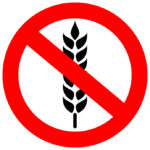Key Facts
- 75% of all grain products in the US are made from wheat flour.
- Wheat allergies are different from celiac disease or gluten intolerance.
- Research shows that approximately 65% of children will outgrow their wheat allergy by the age of twelve.

A wheat allergy is most common in children and is often outgrown by adulthood, but can be outgrown as early as the age of three. Approximately 65% of children with a wheat allergy will outgrow it by the time they are twelve. Many consider a wheat allergy to be one of the most challenging of the top nine food allergens because so many food products in the United States contain wheat. As much as 75% of all grain products are made from wheat flour.
How do I know if a food has wheat in it?
All packaged food products sold in the United States that contain wheat as an ingredient must list the word “wheat” on the food label. Be sure to read all product labels carefully before buying and eating, drinking/consuming any item. Also, avoid foods with any of the following ingredients:
- Bread crumbs
- Bulgur
- Cereal extract
- Club wheat
- Couscous
- Cracker meal
- Durum
- Einkorn
- Emmer
- Farina
- Farro
- Flour (all purpose, bread, cake, durum, enriched, graham, high gluten, high protein, instant, pastry, self-rising, soft wheat, steel ground, stone ground, whole wheat)
- Hydrolyzed wheat protein
- Kamut ®
- Matzoh, matzoh meal (also spelled matzo, matzah, or matza)
- Pasta
- Seitan
- Semolina
- Soy sauce
- Spelt
- Sprouted wheat
- Tricale
- Vital wheat gluten
- Wheat (bran, durum, gluten, grass, malt, sprouts, starch)
- Wheat bran hydrolysate
- Wheat germ oil
- Wheat grass
- Wheat protein isolate
- Whole wheat berries
It is also important to be aware of other ingredients that wheat is sometimes found in, including:
- Glucose syrup
- Surimi
- Starch (gelatinized starch, modified food starch, vegetable starch)
If I have an allergy to wheat, are there any other foods I need to be careful and avoid?
It is important to read all ingredient labels carefully as there are many products that surprisingly contain wheat including some brands of ice cream, marinara sauce, potato chips, rice cakes, turkey patties, and hot dogs. It is also important to be wary of products that could be cross contaminated with wheat, or have “made on shared equipment with wheat” on the label.
Hidden sources of wheat may be found in the following products:
- Ale or beer
- Alcohol
- Baking mixes
- Baked products
- Fried foods
- Breaded foods
- Breakfast cereals
- Candy
- Crackers
- Processed meats
- Salad dressings
- Sauces
- Soups
- Soy sauce
Wheat can also be found in some non-food products including play dough and cosmetic and bath products. It is important to check the manufacturer’s website or contact the company, since allergy labeling is not required by law on nonfood items.
If I have a wheat allergy, what grains can I safely eat?
If you have a wheat allergy, generally you can safely eat non-wheat grains such as:
- Amaranth
- Barley
- Buckwheat
- Corn
- Oats
- Millet
- Rice
- Rye
- Sorghum
- Quinoa
Be sure to talk to your health care provider about which grains are safe for you to eat.
What about baking? Are there any wheat substitutes?
When baking recipes such as brownies or bread that call for wheat flour, it is possible to try the following substitutes (amounts listed are to substitute for one cup of flour):
- 7/8 cup rice flour
- 7/8 cup garbanzo bean (chick pea) flour
- ¾ cup potato starch
- 1-1/3 cups ground rolled oats
- 1 cup tapioca flour
- 1 cup measure for measure wheat-free all purpose flour that can be substituted in place of the normal flour amount (this may be branded as gluten-free flour)
Is a wheat allergy the same as having celiac disease or gluten intolerance?
No. It is easy to confuse celiac disease with a wheat allergy but they are not the same thing. Celiac disease affects the small intestine and is caused by an autoimmune reaction to gluten, the protein found in wheat. It is not an allergic reaction. To learn more about celiac disease and gluten intolerance, please be sure to check out our Gluten Guide. However, many foods labeled “gluten-free” will also be wheat free. Always check the label to ensure there is no wheat product in the food.
How can I tell if I have outgrown my allergy to wheat?
Up to 65% of children who have an allergy to wheat will outgrow their allergy by the age of twelve. Be sure to talk with your health care provider(s) about the status of your food allergy to learn if there are signs that you might be outgrowing it. Your health care provider will be able to check skin and blood tests to detect whether or not the allergy is resolving.
Our health guides are developed through a systematic, rigorous process to ensure accuracy, reliability, and trustworthiness. Written and reviewed by experienced healthcare clinicians from Boston Children's Hospital, a Harvard Medical School teaching hospital and consistently ranked as a top hospital by Newsweek and U.S. News & World Report, these guides combine clinical expertise, specialized knowledge, and evidence-based medicine. We also incorporate research and best practices from authoritative sources such as the CDC, NIH, PubMed, top medical journals, and UpToDate.com. Clinical specialists and subject matter experts review and edit each guide, reinforcing our commitment to high-quality, factual, scientifically accurate health information for young people.
